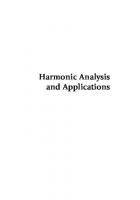Harmonic Geometry: Harmonic Involutions, Harmonic Multilaterals and Harmonic Lines
353 42 348MB
English Pages 783 Year 2018
Table of contents :
Copyright
Forword
Terminology
Bibliography
Part A. Harmonic Involutions
1. In General.
A' Harmonic Involutions in Collinear Series of Points
2. in General
B' Symmetrical Pencils and Collinear Harmonic Involutions
3. Analyzing Symmetrical Central Pencils and Collinear Harmonic Involutions
C'. Method of Symmetrical Pencils
4. Method of the Egress from a Line to Its Plane.
5. Method of Symmetrical Central Pencils.
6. Applications of Properties and Methods.
D' Orthooptical Pencils and Orthooptical Points
7. in General
E' Harmonic Involutions of Cocyclic Series of Points
8. In General
9. Applications
Part B. Harmonic Multilaterals and Harmonic Lines
10. In General
A' Harmonic Collinear Multilaterals
11. In General
B' Regular Central Pencils and Collinear Harmonic Groups of n-Points
12. Review of the Closed Regular Central Pencils and Collinear HarmonicGroups of n Series of Points.
C' Method of Regular Central Pencils.
13. In General.
D' Orthooptical Regular Pencils and Orthooptical Points of Closed Harmonic Groups of n.
14. In General.
15. Applications of the Method of Regular Pencils
E' Harmonic Cocyclic Multilaterals
16. In General.
F. Harmonic Closed Central Pencils and their Intersection from a Line and a Circle
17. Analysis of the Closed Harmonic Central Pencils and their Intersectionsrom a Line and a Circle.
G'. Method of the Harmonic Central Pencils.
18. In General.
19. Applications of the Method of Harmonic Pencils and not only that.
20. The Problem of the Vicennium
21. The Amazing Method of the Harmonic Transformation
22. Applications of the Method of Harmonic Transformation
23. In General.
24. Pairs of Open Central Flat Harmonic and Regular Pencils of 2n Beams and their Orthooptical Points.
25. Applications Relevant to the Pairs of Collinear and Cocyclic Harmonic Lines and Pencils.
Part C. Supplement of Part A
26. In General.
27. Introducing the Method of Harmonic Transformation in Harmonic lnvolutions
Part D. Supplement of Part B.
28. Generally.
29. Applications of Harmonic Multilaterals, mainly using the Method of Harmonic Transformation.
Part E. Auxiliary Propositions (Lemmas)
1. In General.
2. Geometrical Auxiliary Propositions (AP).
Epilogue
Figure Index
Contents
It Was Said
Important remark from page 12:
Author
Copyright
Forword
Terminology
Bibliography
Part A. Harmonic Involutions
1. In General.
A' Harmonic Involutions in Collinear Series of Points
2. in General
B' Symmetrical Pencils and Collinear Harmonic Involutions
3. Analyzing Symmetrical Central Pencils and Collinear Harmonic Involutions
C'. Method of Symmetrical Pencils
4. Method of the Egress from a Line to Its Plane.
5. Method of Symmetrical Central Pencils.
6. Applications of Properties and Methods.
D' Orthooptical Pencils and Orthooptical Points
7. in General
E' Harmonic Involutions of Cocyclic Series of Points
8. In General
9. Applications
Part B. Harmonic Multilaterals and Harmonic Lines
10. In General
A' Harmonic Collinear Multilaterals
11. In General
B' Regular Central Pencils and Collinear Harmonic Groups of n-Points
12. Review of the Closed Regular Central Pencils and Collinear HarmonicGroups of n Series of Points.
C' Method of Regular Central Pencils.
13. In General.
D' Orthooptical Regular Pencils and Orthooptical Points of Closed Harmonic Groups of n.
14. In General.
15. Applications of the Method of Regular Pencils
E' Harmonic Cocyclic Multilaterals
16. In General.
F. Harmonic Closed Central Pencils and their Intersection from a Line and a Circle
17. Analysis of the Closed Harmonic Central Pencils and their Intersectionsrom a Line and a Circle.
G'. Method of the Harmonic Central Pencils.
18. In General.
19. Applications of the Method of Harmonic Pencils and not only that.
20. The Problem of the Vicennium
21. The Amazing Method of the Harmonic Transformation
22. Applications of the Method of Harmonic Transformation
23. In General.
24. Pairs of Open Central Flat Harmonic and Regular Pencils of 2n Beams and their Orthooptical Points.
25. Applications Relevant to the Pairs of Collinear and Cocyclic Harmonic Lines and Pencils.
Part C. Supplement of Part A
26. In General.
27. Introducing the Method of Harmonic Transformation in Harmonic lnvolutions
Part D. Supplement of Part B.
28. Generally.
29. Applications of Harmonic Multilaterals, mainly using the Method of Harmonic Transformation.
Part E. Auxiliary Propositions (Lemmas)
1. In General.
2. Geometrical Auxiliary Propositions (AP).
Epilogue
Figure Index
Contents
It Was Said
Important remark from page 12:
Author










